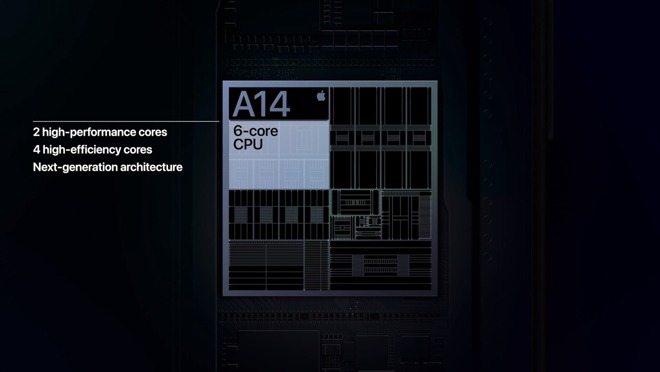iPhone 12 Pro and iPhone 12 Pro Max about 20% faster than iPhone 11 Pro
Preliminary benchmark scores for the iPhone 12 Pro and the iPhone 12 Pro Max have shown up on Geekbench with about a 20% speed improvement over the previous generation.

Benchmark scores show 20% improvement from A13 to A14
The iPhone 12 uses the A14 processor which boasts a 6-core CPU and 4-core GPU in a 5 nanometer process. Apple gave an inscrutable benchmark during its "High, Speed" event of "50% faster than other smartphone processors."
The early Geekbench benchmarks show that Apple improved the overall processing by at least 20% year-over-year, which was in line with the iPad Air 4 early benchmarks.
Scores vary depending on when the benchmark test was run, battery charge, and background operations. Scores will trend lower during initial setup when the iPhone is cataloging a photo library vs a day later on a full charge.
One score for the iPhone 12 Pro showed a 1613 single-core score and a 4076 multi-core score. This compares well to the iPhone 11 Pro at 1343 single-core and 3478 multi-core.
Pre-orders for the iPhone 12 and iPhone 12 Pro start on Friday October 16 at 5 a.m. Pacific time and will begin shipping on October 23. The iPhone 12 mini and iPhone 12 Pro Max will be available to pre-order on November 6, and ship on November 13.

Benchmark scores show 20% improvement from A13 to A14
The iPhone 12 uses the A14 processor which boasts a 6-core CPU and 4-core GPU in a 5 nanometer process. Apple gave an inscrutable benchmark during its "High, Speed" event of "50% faster than other smartphone processors."
The early Geekbench benchmarks show that Apple improved the overall processing by at least 20% year-over-year, which was in line with the iPad Air 4 early benchmarks.
Scores vary depending on when the benchmark test was run, battery charge, and background operations. Scores will trend lower during initial setup when the iPhone is cataloging a photo library vs a day later on a full charge.
One score for the iPhone 12 Pro showed a 1613 single-core score and a 4076 multi-core score. This compares well to the iPhone 11 Pro at 1343 single-core and 3478 multi-core.
Pre-orders for the iPhone 12 and iPhone 12 Pro start on Friday October 16 at 5 a.m. Pacific time and will begin shipping on October 23. The iPhone 12 mini and iPhone 12 Pro Max will be available to pre-order on November 6, and ship on November 13.

Comments
So sad for the haters who were drooling at the early score of 3100 for multi. They were so happy at the prospect the A14 was somehow slower than the A13 only to have those hopes shattered.
That's a nice, but not huge, improvement. Seems like where they really spent their transistor budget was in the Neural Engine.
The Mac silicon is going to be really interesting to see as a lot of things have to be added. They may have SVE/SVE2 units. Still think there is a chance of that. The memory architecture or memory performance will have to be improved by 2x to 4x, possibly 8x, depending on which Mac. The GPU resources would have to be increased 2x, 4x, 8x as well.
We don't know the exact consumption and sustained performance just yet, but I'd expect it to be around the same as the A13 given little to no change in battery life of the new iPhones.